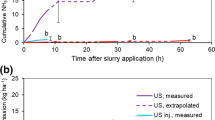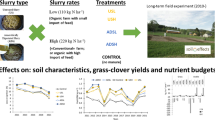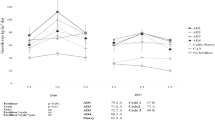Abstract
The anaerobic digestion of source-segregated food waste for the production of biogas has increased significantly in recent years. The digestate produced is a valuable source of plant nutrients such as nitrogen and phosphorus. However, minimising ammonia (NH3) emissions following land application of digestate is important to maximise crop available N supply and reduce environmental impacts. The objectives of this study were (1) to compare NH3 emissions from food-based digestate to those from cattle slurry applied to grassland under comparable conditions and (2) to evaluate the effect of precision application techniques (shallow injection and trailing shoe) on NH3 emissions compared with the conventional surface broadcast method. The results showed that NH3 emissions from broadcast-applied food-based digestate (mean 31% total N applied) were higher than from cattle slurry (mean 21% total N applied), reflecting its higher total N and NH4–N contents, and high pH (mean pH 8.4). Both precision application methods reduced NH3 emissions from food-based digestate by 40–50% in comparison with the surface broadcast treatments, with shallow injection more effective than trailing shoe (P < 0.05). Precision application techniques could be an effective method for reducing NH3 emissions when applying food-based digestate to grassland, providing soil conditions are suitable. Practitioners should be encouraged to use precision application techniques when spreading high N digestates. Given that increasing quantities of food-based digestate are predicted to be produced in the future, failure to mitigate emissions effectively could adversely impact our ability to meet national NH3 reduction targets.

Similar content being viewed by others
References
Anon (1986) The analysis of agricultural materials. Reference book 427, 3rd edition. In: Ministry of agriculture fisheries and food. HMSO, London.
Benford K (2016) The British survey of fertiliser practice. Fertiliser use on farm crops for crop year 2015. https://www.gov.uk/government/uploads/system/uploads/attachment_data/file/516111/fertiliseruse-report2015-14apr16.pdf. Accessed 27 Apr 16
Bhogal A, Nicholson F, Taylor M, Rollett A, Williams J (2016) Crop available nitrogen supply from food-based digestate. In: International fertiliser society proceedings, p 790
DECC/Defra (2011) Anaerobic digestion strategy and action plan. https://www.gov.uk/government/uploads/system/uploads/attachment_data/file/69400/anaerobic-digestion-strat-action-plan.pdf. Accessed 14 Sep 16
Defra (2009) Protecting our water, soil and air: a code of good agricultural practice for farmers, growers and land managers. Department for Environment, Food and Rural Affairs, TSO, Norwich
Defra (2010) Fertiliser manual (RB209), 8th edn. TSO, Norwich
Defra (2016) UK statistics on waste. 15 Dec 2016. https://www.gov.uk/government/uploads/system/uploads/attachment_data/file/593040/UK_statsonwaste_statsnotice_Dec2016_FINALv2_2.pdf. Accessed 27 Apr 17
EC (2010) Preparatory study on food waste across EU 27. Technical report, 2010-054. http://ec.europa.eu/environment/archives/eussd/pdf/bio_foodwaste_report.pdf. Accessed 27 Apr 17
Edwards CA, Lofty R (1982) Nitrogenous fertiliser and earthworm populations in agricultural soils. Soil Biol Biochem 14:515–521
Hansen S, Engelstad F (1999) Earthworm populations in a cool and wet district as affected by tractor traffic and fertilisation. Appl Soil Ecol 13:237–250
Hoeksma P, Mosquera J, Melse RW (2012) Monitoring methane and nitrous oxide reduction by manure treatment. Report 627. Wageningen UR Livestock Research, the Netherlands
Huijsmans JFM, Hol JMG, Hendriks MMWB (2001) Effect of application technique, manure characteristics, weather and field conditions on ammonia volatilization from manure applied to grassland. Neth J Agric Sci 49(4):323–342
Lalor STJ, Hoekstra NJ, Murphy PNC, Richards KG, Lanigan GJ (2012) Practical advice for slurry application strategies for grassland systems. In: Proceedings 712 of the international fertiliser society
Lockyer DR (1984) A system for the measurement of in the field losses of ammonia through volatilisation. J Sci Food Agric 35(8):837–848
Madani-Hosseini M, Mulligan CN, Barrington S (2016) Acidification of in-storage-psychrophilic-anaerobic-digestion (ISPAD) process to reduce ammonia volatilization: model development and validation. Waste Manag 52:104–111
Misselbrook TH, Smith KA, Johnson RA, Pain BF (2002) Slurry application techniques to reduce ammonia emissions: results of some UK Field-Scale Experiments. Biosyst Eng 81(3):313–321
Misselbrook TH, Nicholson FA, Chambers BJ (2004) Predicting ammonia loss following the application of livestock manure to land. Biores Technol 96(2):159–168
Misselbrook TH, Gilhespy SL, Cardenas LM, Williams J, Dragostis U (2015) Inventory of ammonia emissions from UK agriculture 2014. Report for Defra project SCF0102
Nicholson FA, Bhogal A, Chadwick D, Gill E, Gooday RD, Lord E, Misselbrook T, Rollett AJ, Sagoo E, Smith KA, Thorman RE, Williams JR, Chambers BJ (2013) An enhanced software tool to support better use of manure nutrients: MANNER-NPK. Soil Use Manag 29:473–484
Peacock AD, Mullen MD, Ringelberg DB, Tyler DD, Hedrick DB, Gale PM, White DC (2001) Soil microbial community responses to dairy manure or ammonium nitrate applications. Soil Biol Biochem 33:1011–1019
Rubaek GH, Henriksen K, Rasmussen J, Petersen J, Sommer SG (1996) Effects of application technique and anaerobic digestion on gaseous nitrogen loss from animal slurry applied to ryegrass (Lolium perenne). J Agric Sci 126:481–492
Smith KA, Jackson DR, Misselbrook TH, Pain BF, Johnson RA (2000) Reduction of ammonia emission by slurry application techniques. J Agric Eng Res 77(3):277–287
Sogaard HT, Sommer SG, Hutchings NJ, Huijsmans JFM, Bussink DW, Nicholson F (2002) Ammonia volatilization from field-applied animal slurry—the ALFAM model. Atmos Environ 36:3309–3319
Sommer SG, Friis E, Bach A, Schjorring JK (1997) Ammonia volatilization from pig slurry applied with trail hoses or broadspread to winter wheat: effects of crop developmental stage, microclimate, and leaf ammonia absorption. J Environ Qual 26(4):1153–1160
Styles D, Dominguez EM, Chadwick D (2016) Environmental balance of the UK biogas sector: an evaluation by consequential life cycle assessment. Sci Total Environ 560:241–253
Thorman RE, Hansen MN, Misselbrook TH, Sommer SG (2008) Algorithm for estimating the crop height effect on ammonia emission from slurry applied to cereal fields and grassland. Agron Sustain Dev 28(3):373–378
Tiwary A, Williams ID, Pant DC, Kishore VVN (2015) Assessment and mitigation of the environmental burdens to air from land applied food-based digestate. Environ Pollut 203:262–270
UNECE (2007) Guidance document on control techniques for preventing and abating emissions of ammonia. United Nations Economic Commissions for Europe (UNECE), Geneva
Webb J, Menzi H, Pain BF, Misselbrook TH, Dämmgen U, Hendriks G, Döhler H (2004) Managing ammonia emissions from livestock production in Europe. Environ Pollut 135:399–406
WRAP (2014) A survey of the UK anaerobic digestion industry in 2013 (ASORI). http://www.wrap.org.uk/content/survey-uk-anaerobic-digestion-industry-2013. Accessed 9 Oct 2017
WRAP (2016) Digestate and compost use in agriculture: good practice guidance. http://www.wrap.org.uk/sites/files/wrap/WRAP_Digestate_and_compost_use_in_agriculture_for_farmers_growers_and_advisers.pdf
Wulf S, Maeting M, Clemens J (2002) Application technique and slurry co-fermentation effects on ammonia, nitrous oxide and methane emissions after spreading. I. Ammonia volatilization. J Environ Qual 31:1789–1794
Acknowledgements
This study was part of the DC-Agri project funded by the Waste Recycling Action Programme (Grant No. OMK001-001), Zero Waste Scotland, the Department for Environment, Food and Rural Affairs, and the Scottish and Welsh Governments.
Author information
Authors and Affiliations
Corresponding author
Rights and permissions
About this article
Cite this article
Nicholson, F.A., Bhogal, A., Rollett, A. et al. Precision application techniques reduce ammonia emissions following food-based digestate applications to grassland. Nutr Cycl Agroecosyst 110, 151–159 (2018). https://doi.org/10.1007/s10705-017-9884-4
Received:
Accepted:
Published:
Issue Date:
DOI: https://doi.org/10.1007/s10705-017-9884-4




